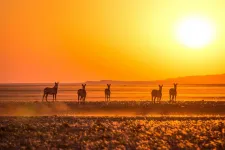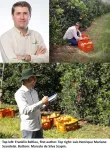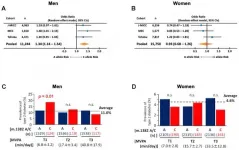(Press-News.org) In the Namib Desert in southwestern Africa, the Kuiseb River, an ephemeral river which is dry most of the year, plays a vital role to the region. It provides most of the vegetation to the area and serves as a home for the local indigenous people, and migration corridor for many animals. The overall vegetation cover increased by 33% between 1984 and 2019, according to a Dartmouth study published in Remote Sensing .
The study leveraged recent drone imagery and past satellite imagery to estimate past vegetation cover in this linear oasis of the Kuiseb River, a fertile area in the middle of one of the driest deserts on the earth. The findings are significant, as this is the first study to reconstruct decades of vegetation change over a long stretch of the river, rather than at just a few sites.
The research was based on a senior thesis project by Bryn E. Morgan '17, first author of the study, who has a bachelor's degree in geography and chemistry from Dartmouth, and is now a Ph.D. student in the WAVES Lab at the University of California, Santa Barbara. She first visited the Namib Desert, which is located along the coast of Namibia, in 2015 as part of the environmental studies foreign studies program , led by study co-author Douglas T. Bolger (https://envs.dartmouth.edu/people/douglas-thomas-bolger), a professor and chair of environmental studies at Dartmouth. Morgan returned to the region on her own in 2016, to conduct this research while working out of the Gobabeb Namib Research Institute and continued this work after graduating from Dartmouth.
The study area consisted of a 112-kilometer stretch of the lower Kuiseb River, which was comprised of 12 sites along the river, each of which was 500 meters wide. At each site, Morgan flew one to four unmanned aerial vehicle or drone flights to capture images of the woody vegetation cover along the river. One drone flight would take images with true color and then another flight would take images with false color using near infrared wavelengths of light, which are outside what our eyes can see. False color imagery allows one to distinguish vegetation from sand and soil, and differentiate the various types of vegetation and how healthy it may be.
The drone imagery revealed that five species of trees are part of the vegetation cover in the area: Acacia (Vachellia) erioloba, Faidherbia albida, Euclea pseudebenus, Tamrix usneoides, and Salvadora persica. A. erioloba and F. albida have been named national conservation priorities and their pods are an important food source to the livestock of the Topnaar (?Aonin), the indigenous people who live along the Kuiseb River. The Kuiseb also serves as a habitat and migration corridor for many animals, including the mountain zebra, leopard and ostrich.
Based on the 2016 data, the research team created a model that calculated the fractional vegetation cover of the lower Kuiseb River based on raw reflectance values. By matching past satellite images for the previous 30 years to the present-day imagery, and then applying the same model, the team was able to estimate past and vegetation cover. "Essentially, the drone data worked as a bridge from the ground to what the satellite was seeing," explains co-author Jonathan Chipman , director of the Citrin Family GIS/Applied Spatial Analysis Laboratory at Dartmouth. "Our methods in the study provide a model for how ecologists can combine modern drone imagery and historic satellite data to reconstruct past environmental change."
The results showed that one area of the Kuiseb River located between 110 and 140 kilometers upstream from the Atlantic Ocean in the terminal alluvial zone, which is typically dry but within the reach of floods and where soil sediments are deposited, not only had the highest vegetation but also had the most positive change in vegetation cover over the study period.
"Our findings demonstrate that vegetation cover in the lower Kuiseb River has been, on average, increasing for more than three decades," says Morgan. "As a result, we provide new insight into not only the long-term change in the hydrology and ecology of this system but also into how ephemeral rivers in desert landscapes might be responding to global change."
The research team examined the climate and hydrological records to see if increased precipitation between 1984 and 2019 may explain the overall change in vegetation cover; however, the records did not show such steady increases in precipitation. According to the co-authors, the increase in vegetation cover may reflect a long-term recovery from the drought in the Namib Desert during the early 1980s, which could be investigated by using coarser-resolution satellite data prior to 1984.
INFORMATION:
Morgan (brynmorgan@ucsb.edu) and Chipman (jonathan.w.chipman@dartmouth.edu) are available for comment about the study. In addition to Morgan, Chipman and Bolger, James T. Dietrich, a Neukom Fellow at Dartmouth at the time of the study and now an assistant professor in geography at the University of Northern Iowa, also served as a co-author.
Some of the most commonly used drugs for treating hereditary breast and ovarian cancers may not work the way we thought they did, according to new University of Colorado Boulder research.
The paper, published February 2 in the journal Nature Communications, sheds new light on how they do work and could open the door to new next-generation medications that work better, the authors said.
"Despite the success of these drugs which sell in the billions of dollars per year and treat many thousands of patients, there are many unknowns about their potency and efficacy that if better understood ...
BUFFALO, N.Y. - A popular streaming service boasts a film inventory approaching 4,000 titles. When it's time to pick a movie, are you more likely to quickly make a decision or meticulously sift through the possibilities?
Psychologists refer to those who search minimally for something to arrive at an adequate choice as "satisficers." It's the "maximizers," meantime, who search exhaustively for what might be considered as the perfect option.
Previous studies exploring both strategies after making a choice often present satisficing as a more psychologically ...
An important bacterial disease that affects citrus trees and causes lesions, citrus canker has been effectively controlled by spraying copper. However standard management techniques involve spraying excessive amounts of copper and water without consideration for the size of the trees.
"This technique resulted in a waste of resources as well as higher costs, detrimental environmental impact, and risk for development of copper resistant strains," explained plant pathologist Franklin Behlau, who recently published an article discussing a more sustainable approach to managing citrus canker.
Behlau and his colleagues showed that it is possible to control citrus canker by spraying ...
The instrumental climate record is the cultural heritage of humankind, the result of the diligent work of many generations of people all over the world. However, the changes in the way in which temperature is measured, as well as the environment in which weather stations are located can produce spurious trends. An international study carried out by researchers from the Universitat Rovira i Virgili (URV), the State Meteorology Agency and the University of Bonn (Germany) have succeeded in identifying the most reliable methods that help correct these trends. These "homogenization methods" are a key step in converting the enormous effort made by observers into reliable data about climate change. The results of this research, funded by ...
The inauguration of Joe Biden and Kamala Harris marks a new era for science policy in the U.S. and beyond. The new administration has inherited a global pandemic and worsening climate change, among other science-related issues. A cover story in Chemical & Engineering News (C&EN), the weekly newsmagazine of the American Chemical Society, delves into what this means for chemists and chemistry as a whole.
One of the most pressing issues facing the Biden administration is the fight against climate change. Biden campaigned on net-zero emissions of greenhouse gases by 2050 and has laid out a sweeping plan to switch the U.S. to cleaner energy sources, which experts say ...
For decades, scientists have wrestled with rival theories to explain how interactions between species, like competition, influence biodiversity. Tracking microbial life across the planet, researchers from McGill University show that biodiversity does in fact foster further diversity in microbiomes that are initially less diverse. However, diversity rates plateau with increased competition for survival and space in more diverse microbiomes.
Published in eLife, the findings could help scientists better understand how microbiomes - communities of micro-organisms living together in particular habitats like humans, animals and plants or even soils and oceans ...
C polymorphism is associated with susceptibility to T2D in men, possibly interacting with exercise, and contributing to the risk of T2D in sedentary males by reducing the activity of MOTS-c.
Dr. Noriyuki Fuku from The Juntendo University and Dr. Pinchas Cohen from The University of Southern California said, "The prevalence of type 2 diabetes mellitus (T2D) is growing dramatically."
While diabetes syndromes directly caused by mutations in mtDNA are extremely rare, several genetic analyses reveal that mtDNA polymorphisms contribute to T2D risk in both European ...
Aging-US published "Screening of Alzheimer's disease by facial complexion using artificial intelligence" which reported that despite the increasing incidence and high morbidity associated with dementia, a simple, non-invasive, and inexpensive method of screening for dementia is yet to be discovered.
This study aimed to examine whether artificial intelligence could distinguish between the faces of people with cognitive impairment and those without dementia.
121 patients with cognitive impairment and 117 cognitively sound participants were recruited for the study.
The binary differentiation of dementia / non-dementia facial image was expressed as a "Face AI score".
However, MMSE score showed significantly stronger ...
Aging-US published "Sulforaphane promotes C. elegans longevity and healthspan via DAF- 16/DAF-2 insulin/IGF-1 signaling" which reported that the broccoli-derived isothiocyanate sulforaphane inhibits inflammation, oxidative stress and cancer, but its effect on healthspan and longevity are unclear.
The authors used the C. elegans nematode model and fed the wildtype and 9 mutant strains ±sulforaphane.
Sulforaphane increased the lifespan and promoted a health-related phenotype by increasing mobility, appetite and food intake and reducing lipofuscin accumulation.
Mechanistically, sulforaphane inhibited DAF-2-mediated insulin/insulin-like growth factor signaling and its downstream targets AGE-1, AKT-1/AKT-2. This was associated with increased nuclear translocation of ...
Amsterdam, NL, February 3, 2021 - Patients with Parkinson's disease (PD) and healthcare professionals caring for them have expressed concerns about the COVID-19 vaccine's efficacy and safety in the specific context of PD and its symptomatic treatment. In a END ...





